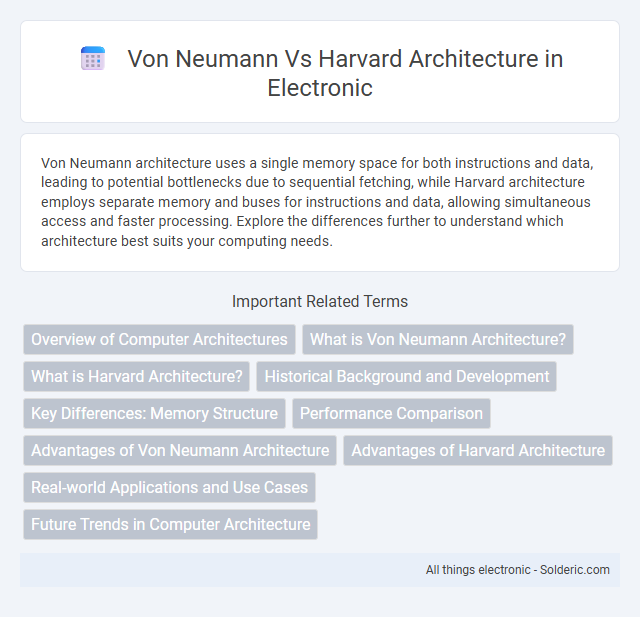Von Neumann architecture uses a single memory space for both instructions and data, leading to potential bottlenecks due to sequential fetching, while Harvard architecture employs separate memory and buses for instructions and data, allowing simultaneous access and faster processing. Explore the differences further to understand which architecture best suits your computing needs.
Comparison Table
| Feature | Von Neumann Architecture | Harvard Architecture |
|---|---|---|
| Memory | Single shared memory for data and instructions | Separate memories for data and instructions |
| Data Bus | Single data bus for both data and instructions | Separate data buses for data and instructions |
| Speed | Slower due to single bus bottleneck (von Neumann bottleneck) | Faster, as instructions and data can be accessed simultaneously |
| Complexity | Simpler design, easier to implement | More complex design, higher implementation cost |
| Use Case | General-purpose computers | DSPs, embedded systems, and specialized processors |
| Instruction Execution | Fetches instructions and data sequentially | Fetches instructions and data in parallel |
| Flexibility | More flexible in memory usage | Less flexible due to fixed memory split |
Overview of Computer Architectures
Von Neumann architecture features a single shared memory for instructions and data, enabling a streamlined but sequential processing model that can lead to the von Neumann bottleneck. Harvard architecture employs separate memory spaces and buses for instructions and data, allowing simultaneous access and improving processing speed and efficiency. These fundamental structural differences impact overall system performance, influencing design choices in modern computing devices.
What is Von Neumann Architecture?
Von Neumann Architecture is a computer design model featuring a single shared memory space for both data and instructions, allowing sequential processing of tasks. This architecture relies on a central processing unit (CPU) that fetches and executes instructions stored in the same memory, which can lead to a bottleneck known as the Von Neumann bottleneck. Understanding this architecture is crucial for optimizing your system's performance and memory management strategies.
What is Harvard Architecture?
Harvard Architecture is a computer architecture with separate memory storage and signal pathways for instructions and data, allowing simultaneous access and improving processing speed. This separation reduces bottlenecks compared to the Von Neumann Architecture, where a single memory space stores both instructions and data. Commonly used in embedded systems and digital signal processors, Harvard Architecture enhances system efficiency and throughput by parallelizing memory operations.
Historical Background and Development
Von Neumann architecture, developed in the 1940s by John von Neumann and his colleagues, introduced the concept of a stored-program computer where data and instructions share the same memory space. In contrast, Harvard architecture originated from the Harvard Mark I computer, designed by Howard Aiken in the 1940s, featuring separate memory storage for instructions and data, enabling simultaneous access and faster processing. Your choice between these architectures affects system performance and complexity based on their historical design principles and intended applications.
Key Differences: Memory Structure
The Von Neumann architecture employs a single unified memory space for both instructions and data, leading to potential bottlenecks known as the Von Neumann bottleneck. In contrast, the Harvard architecture utilizes separate memory units for instructions and data, allowing simultaneous access and increased processing speed. This fundamental difference in memory structure impacts overall system performance and complexity, with Harvard architecture often favored in embedded systems and digital signal processors.
Performance Comparison
Von Neumann architecture features a unified memory for instructions and data, often causing a bottleneck known as the von Neumann bottleneck that limits data throughput and overall performance. Harvard architecture separates instruction and data memory, enabling simultaneous access and higher data throughput, which typically results in faster execution speeds and improved performance for specialized tasks. Understanding these differences helps you choose the most efficient architecture for applications requiring quick data processing or parallelism.
Advantages of Von Neumann Architecture
Von Neumann architecture offers simplicity and cost-efficiency by using a single memory space for both instructions and data, reducing hardware complexity. This unified memory model allows for easier programming and flexibility in executing instructions sequentially. Its design supports a wide range of applications, making it ideal for general-purpose computing systems.
Advantages of Harvard Architecture
Harvard architecture offers significant advantages in performance by providing separate memory spaces and buses for instructions and data, enabling simultaneous access and reducing bottlenecks. This separation enhances instruction throughput and supports faster and more efficient pipeline processing, essential for real-time and embedded systems. The architecture also improves security by isolating code and data storage, minimizing the risk of accidental or malicious data corruption in critical applications.
Real-world Applications and Use Cases
Von Neumann architecture is widely used in general-purpose computers, such as desktops and laptops, due to its ability to efficiently handle sequential processing tasks and run versatile software applications. Harvard architecture is favored in embedded systems, digital signal processors (DSPs), and microcontrollers where performance and speed are critical, enabling simultaneous instruction and data access for real-time processing. Industrial automation, automotive control systems, and high-performance audio processing commonly leverage Harvard architecture for optimized throughput and low latency.
Future Trends in Computer Architecture
Future trends in computer architecture indicate a growing shift towards hybrid models that combine aspects of Von Neumann and Harvard architectures to maximize performance and efficiency. Emerging designs emphasize parallelism and specialized processing units, leveraging the Harvard architecture's separate memory pathways while maintaining the Von Neumann model's programmable flexibility. Your computing systems will benefit from increased speed, reduced latency, and enhanced scalability as these architectures evolve to meet the demands of AI, big data, and real-time processing workloads.
von neumann vs harvard architecture Infographic

 solderic.com
solderic.com